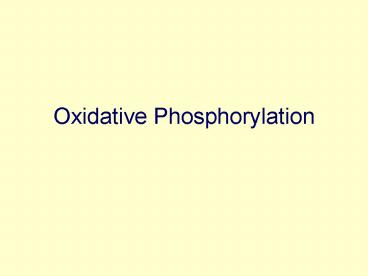Oxidative Phosphorylation - PowerPoint PPT Presentation
1 / 22
Title:
Oxidative Phosphorylation
Description:
3. Mitochondrial membranes are impermeable to ions and small molecules. 4. Mitochondria have their own DNA genome. Coupled Transport Across Mitochondrial Membranes ... – PowerPoint PPT presentation
Number of Views:3347
Avg rating:3.0/5.0
Title: Oxidative Phosphorylation
1
Oxidative Phosphorylation
2
What is the most important feature of
mitochondria with respect to generation of energy?
- 1. There are many mitochondria per cell
- 2. Mitochondria contain enzymes of the citric
acid cycle - 3. Mitochondrial membranes are impermeable to
ions and small molecules - 4. Mitochondria have their own DNA genome
3
Coupled Transport Across Mitochondrial Membranes
- Pyruvate, ADP, Pi pumped in, ATP moved out
- Carrier proteins can couple transport to
energetically favorable flow of H into the
matrix - ADP co-transported (antiport) with ATP driven by
charge difference across membrane - Thus proton gradient drives formation of ATP and
transport of metabolites
4
Coupled Transport in Mitochondria
5
Proton Gradient Produces Most of Cells ATP
- Glycolysis 2 ATP/ molecule glucose in absence of
O2 - Oxidative phosphorylation provides 2.5 ATP/NADH,
1.5 ATP/FADH2 - Complete oxidation of glucose yields 30
ATP/molecule glucose - Also generate large ATP from oxidation of fats
- Maintains high ATP/ADP ratio in cells
6
ATP Production
- ATP main energy currency of the cell
- Glycolysis preserves 10 free energy of glucose
- Majority of ATP synthesized in membrane-bound
process in mitochondria - Oxidative phosphorylation
- Stage 1 Electrons passed along
electron-transport chain, release energy to pump
H - Stage 2 H flow down electrochemical gradient to
synthesize ATP - Chemiosmotic coupling
7
Structure of Mitochondria
- Present in large numbers in cell
- Can be localized at sites of high ATP consumption
- Inner and outer membranes
- Outer membrane permeable to proteins lt5000 D
- Inner membrane impermeable to ions and most small
molecules in absence of transport proteins - Matrix and intermembrane space
- Matrix contains molecules that can be transported
across inner membrane
8
Mitochondria
9
Inner Membrane
- Contains transmembrane ATP synthase
- Proteins of electron transport chains
- Distinct lipid composition
- Contains a variety of transport proteins
- Pyruvate, fatty acids
- Highly convoluted to provide greater surface area
- Cristae
10
What tissues would be affected in diseases where
mitochondria are abnormal?
- 1. Brain
- 2. Liver
- 3. Heart
- 4. Eyes
- 5. Skeletal muscle
11
High Energy Electrons from Citric Acid Cycle
- Acetyl CoA ? CO2 H2O
- NADH and FADH2 generated
- High energy electrons transferred to inner
mitochondrial membrane - Electrons enter electron transport chain
- Regeneration of NAD and FAD
12
Electron-Transport Chains
- Membrane-based energy-conservation
- Protons are moved by the transfer of electrons
- Water is a reservoir for donation and acceptance
of protons - When an electron is acquired it brings along a
negative charge - Charge neutralized by rapid addition of a proton
from water - Net effect is transfer of entire H atom, He-
- When a molecule is oxidized, H atom dissociated
into electron and proton - Electron passed to electron acceptor, proton to
water
13
Chemiosmotic Process
- Chemiosmotic process converts high energy
electrons to ATP - High energy electrons passed along electron
transport chain to molecular O2 to form H2O - Energy released pumps protons across membrane
- Discharge of proton gradient provides energy to
ATP synthase to make ATP
14
Mitochondria Catalyze Conversion of Energy
15
Electron Transfer
- Each electron transfer is an oxidation-reduction
reaction - Electrons pass readily from molecules with low
affinity for electrons to molecules with a high
affinity - Electron transfer occurs in proteins that can
pump protons from water across membrane to
intermembrane space - Creates electrochemical gradient
16
Proton Gradient
- Gradient of proton concentration across inner
membrane - pH gradient
- Matrix pH 8, intermembrane space pH 7
- Generates a membrane potential
- Inside of membrane negatively charged
- Outside of membrane positively charged
17
The Electrochemical Gradient Across the Inner
Mitochondrial Membrane Consists of Membrane
Potential
18
And A Smaller Force Due to the Proton
Concentration
19
ATP Synthase
- Membrane-bound, multisubunit enzyme
- Creates a hydrophilic pathway across inner
mitochondrial membrane - Allows protons to flow down electrochemical
gradient - As ions flow through channel, drive reaction ADP
Pi ? ATP - Energy-converting molecular motor
- Can produce 100 molecules ATP per second
- Reversible
20
The Electrochemical Gradient Drives ATP Synthesis
by Oxidative Phosphorylation
21
Electron Transport Chains
- Protons are moved by the transfer of electrons
- Water is a reservoir for donation and acceptance
of protons - When an electron is acquired it brings along a
negative charge - Charge neutralized by rapid addition of a proton
from water - Net effect is transfer of entire H atom, He-
- When a molecule is oxidized, H atom dissociates
into electron and proton - Electron passed to electron acceptor, proton to
water
22
Protons in Water Are Highly Mobile































